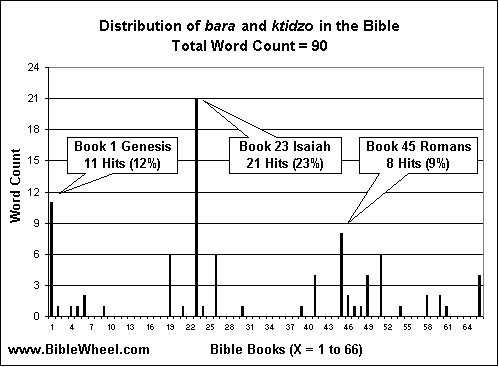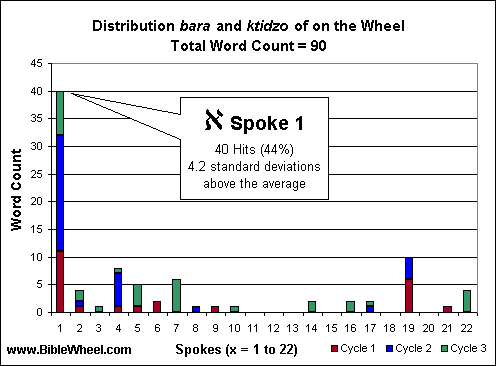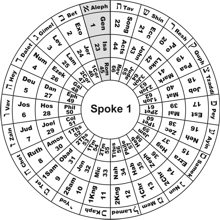The Theeme of Creation Dominates the First Spoke
Drop down, ye heavens, from
above, and let the skies pour down righteousness: let the earth
open, and let them bring forth salvation, and let righteousness
spring up together; I the LORD have created it.
Isaiah 45:8 (Spoke 1, Cycle 2)
Of all the themes uniting Genesis, Isaiah, and Romans, the most
obvious is that of creation. In this connection, Watts, whom we consulted in A
Great Cloud of Witnesses had this insight to offer:
Every student of Hebrew is aware the word ‘create’ in Genesis 1 is a rare
word used only with God as subject. The highest concentration of uses of that
word occurs in Isaiah 40 – 66. If there should be any fear that Isaiah’s
emphasis on God as the owner of Canaan represents a provincial and limited
picture of God, this fact should dispel it.
This theme of creation, initiated in Genesis and amplified in Isaiah, figures prominently
in Romans as well. The thematic correlation linking these three books can be mathematically
measured by analyzing the global distribution of words relating to creation throughout
the Bible.
In Hebrew, the primary triliteral root verb of interest is ברא (bara, create). This is the word Watts referred to above, and it is the root
of the word translated as created in Isaiah 45.8. When this verse was translated
into Greek in the Septuagint, the verb κτιζω (ktidzo, create) was used, or
rather, the absolute form of this verb, ο κτισαϛ (ho ktisas). This specific
form of ktidzo, rarely used in the New Testament, is found in Romans 1.25 where
it is translated as the Creator. The relation between ktidzo and create is
clearly displayed in the King James Version, where all occurrences of the Greek
ktidzo are translated into the English create or one of its cognates (created,
createth, creates, etc.), and every occurrence of English words based on create
correspond to ktidzo in the Greek. In other words, there is a one-to-one
correspondence between the Greek ktidzo and English create in the KJV. Likewise,
there is a one-to-one correspondence between create and bara in the King James
Version of Isaiah, though in a few verses of other Old Testament books, bara is
translated in other ways. The relation between the two roots ktidzo and bara was
noted by Thayer in his Greek-English Lexicon of the New Testament, where he
reported that ktidzo is used chiefly for the bara in the Septuagint. The point
of all this discussion is simply this: bara and ktidzo are the primary Hebrew
and Greek words used in Scripture to speak of creation.
The graph below displays the results of searching the entire
Bible for all occurrences of words based on these two roots. The horizontal
x-axis, ranging from 1 to 66, represents the books of the Bible and the vertical
y-axis represents the total number of occurrences, or 'hits', found in each
book. The search resulted in a total of 90 hits, which gives an average of about
1.4 (= 90/66) hits per book. The most notable feature of the graph is the
prominent peak corresponding to the 21 hits found in the book of Isaiah, which
means that bara occurs 15 times above average in his great book. It is
quite obvious, therefore, that Watts was correct in his assertion about the
distribution of this word in the Bible. Another highly significant feature of
the graph is that each book initiating a Cycle of the Wheel contains the maximum
number of hits in that Cycle. Genesis contains the maximum number of hits found
in the first 22 books, Isaiah contains the maximum found in the next 22 books,
and Romans contains the maximum found in the final 22 books, though in this
latter case the peak is not so pronounced. This means that of all the books in
the Bible, Genesis, Isaiah, and Romans contain the absolute maximum
number of occurrences of the creation root words bara and ktidzo.

We can redisplay these same results with the x-axis now representing the Spokes of the Wheel ranging from 1
to 22. The three Cycles are stacked one atop the other and distinguished by
color; the red, blue, and green bars corresponding to Cycle 1, Cycle 2, and
Cycle 3 respectively.
This graph makes the correlation amongst the three Cycles visually
self-evident. We now have an average of 4.1 (=90/22) hits per Spoke so
the maximum value of 40 hits found on Spoke 1 is nearly ten times the
average.

Yet there is more. Calculating the
correlation coefficient for each pair of the three Cycles yields the following:
Cycles 1 and 2: CC = .90
Cycles 1 and 3: CC = .50
Cycles 2 and 3: CC = .60
Simply stated, such magnitiudes do not happen by chance. Note in particular the value of
.90 for correlation between Cycle 1 and Cycle 2. This is an extremely
high value rarely seen anywhere in science. Its significance shines forth when we consider
that there is absolutely no reason (from a naturalistic perspective)
to expect any correlation whatsoever! If the Bible were the product of mere men, we would
expect a value close to zero, not unity!
All of these facts conspire to demonstrate the divine design of the Holy Bible.
Yet there is more! Could God have chosen a more appropriate theme to
initiate his Wheel? Indeed, this is where all creation begins, as it is written
in the first verse of the first Book of the first Spoke, "In the beginning
God created the heaven and the earth." The miracle of the Wheel is that it
integrates the plain message of Scripture with the simple geometry of the
perfect Circle and the twenty-two letters of the Hebrew alphabet. Such is the
wonder of the Word of our infinitely wise God!
|



